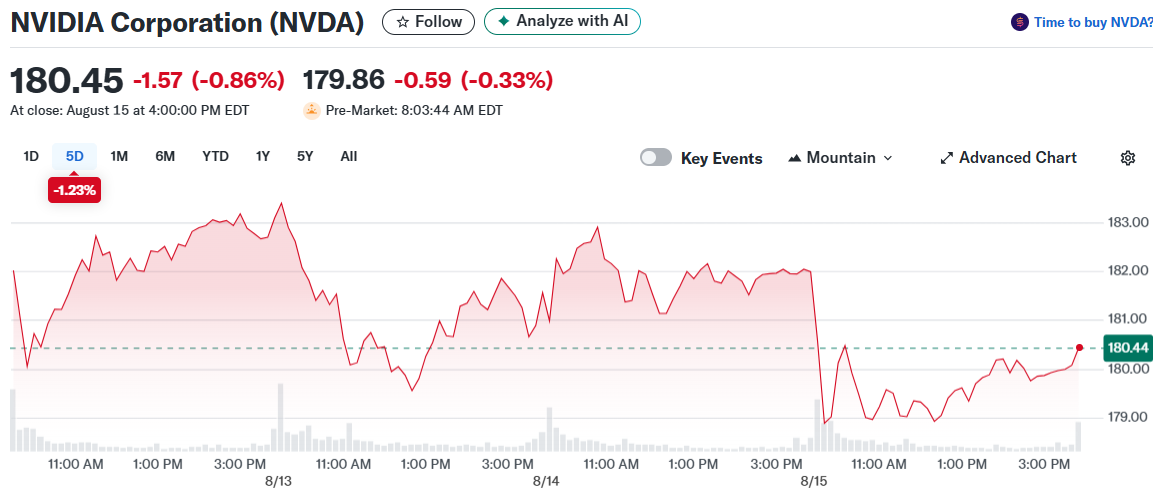TLDR
- Nvidia stock fell 0.6% in premarket trading Monday ahead of its Aug. 27 earnings report
- Company pushed back against analyst reports suggesting delays in next-generation Rubin chip production
- Trump agreed to let Nvidia sell downgraded H20 GPUs in China for 15% revenue cut to US government
- Hyperscaler capital spending on track to reach $445 billion this year, up 56% from last year
- Wall Street expects Nvidia’s adjusted earnings to grow 43% annually through fiscal 2027
Nvidia stock slipped in early Monday trading as investors await the company’s quarterly earnings report next week. The AI chip maker also dealt with analyst concerns about its next-generation processors.

Shares dropped 0.6% to $179.37 in premarket trading. The stock fell 0.9% on Friday.
The decline comes as Nvidia trades in line with broader market movements. Investors appear to be positioning ahead of the company’s earnings report scheduled for Aug. 27.
Chip Production Timeline Questioned
Nvidia faced questions about potential delays in its next-generation Rubin hardware. Some analysts suggested the company might be pushing back production to better compete with chips from rival Advanced Micro Devices.
Jefferies analysts pushed back against these concerns. They believe any production delays are overblown.
“We are not refuting whether or not a metal change may have been needed, as is the case with many chips,” wrote Jefferies equity sales specialist William Beavington in a research note Sunday. “But we believe the timing is on track for production to start in 2Q26 and server volumes to start late 3Q26.”
The Rubin architecture represents Nvidia’s next step beyond its current Blackwell GPUs. Any delays could affect the company’s competitive position in the rapidly evolving AI chip market.
Other semiconductor stocks also declined Monday morning. Advanced Micro Devices fell 1% while Broadcom dropped 0.7% in premarket trading.
China Market Access Restored
President Trump recently reached an agreement allowing Nvidia to sell downgraded H20 GPUs in China. The deal requires Nvidia to pay 15% of revenue from these sales to the US government.
The arrangement reverses earlier export restrictions that had blocked Nvidia from the Chinese market. The company took a $4.5 billion charge in the first quarter related to excess inventory after losing China access.
CFO Collette Kress previously warned that losing access to China’s AI accelerator market, expected to reach nearly $50 billion, would have a material impact on the business. The new agreement provides a path back into this market.
Trump is reportedly open to a similar arrangement for Nvidia’s Blackwell GPUs. The company would need to create a scaled-back version, similar to how the H20 chip is based on the Hopper architecture.
China represents the second-largest AI market globally. Access to this market could provide new revenue streams for Nvidia going forward.
Hyperscaler Spending Exceeds Expectations
Capital spending among the 11 largest hyperscale companies is tracking ahead of Wall Street projections. These companies are on pace to spend $445 billion this year, up 56% from last year according to Morgan Stanley.
This exceeds previous estimates of $410 billion in capital expenditure growth of 44% for 2025. The increased spending reflects higher than expected investment in AI infrastructure.
Hyperscalers include Amazon, Microsoft, Alphabet, Meta Platforms, Oracle, CoreWeave, Apple and other large-scale cloud computing providers. Their spending decisions provide insight into future technology trends.
Bank of America estimates spending on data center AI systems will grow 26% annually through 2030. Nearly 90% of this spending will go toward AI accelerators and networking hardware.
Nvidia holds leadership positions in both markets. The company accounts for about 80% of AI accelerator sales and over 50% of generative AI networking equipment sales.
Several analysts have raised their earnings forecasts for Nvidia based on the stronger hyperscaler spending trends. The consensus estimate now projects adjusted earnings growth of 43% annually through fiscal year ending January 2027.
Stay Ahead of the Market with Benzinga Pro!
Want to trade like a pro? Benzinga Pro gives you the edge you need in today's fast-paced markets. Get real-time news, exclusive insights, and powerful tools trusted by professional traders:
- Breaking market-moving stories before they hit mainstream media
- Live audio squawk for hands-free market updates
- Advanced stock scanner to spot promising trades
- Expert trade ideas and on-demand support



